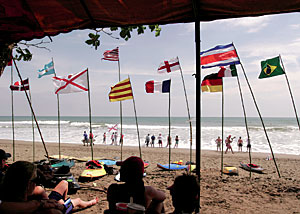- Tahoe’s Nevada Beach Tops the List of Hard-to-Book Campgrounds - 07/17/2024
- Cannabis Watershed Protection Program Cleans Up Illegal Grow Sites - 07/10/2024
- French Fire - 07/05/2024
Athletes need to be extra vigilant to protect their eyes
By Dr. Michael Furlong
![]()
While most of us spend countless hours thinking about how to improve our fitness, reach a new personal record, and even shave grams from our bikes, we spend virtually no time thinking about how to protect our eyes during our various activities and adventures. And that can be a critical, life-changing mistake.
In the past several decades, as participation in all sorts of sporting activities has blossomed, there’s been a simultaneous rise in eye injuries. Sports and recreational activities cause more than 40,000 eye injuries each year, according to the American Academy of Ophthalmology, and it’s estimated that between 70,000 and 300,000 more eye injuries go unreported. More than 90 percent of these eye injuries could be prevented through proper eye care and appropriate eye protection.
April marks Sports Eye Safety Month, a reminder for athletes to give greater consideration to this most cherished asset that so many of us take for granted. Without good vision, our ability to engage in cycling, running, skiing, rock climbing and almost any other favorite activity is severely compromised.
Whether you are a weekend warrior, avid age group competitor or professional athlete, regular eye exams can help ensure healthy vision. Seeing your ophthalmologist once a year helps detect potential problems, such as glaucoma, macular degeneration or diabetes, that can cause blindness if left untreated. These diseases often go undetected because they don’t cause pain or show symptoms until it is too late. It is also important to keep your contact lenses or prescription glasses prescriptions up to date. Our vision changes and if your corrective eyewear is not optimized you might misjudge a turn in the trail or a pothole in the street that could send you flying.
Athletes who see their eye doctors on a regular basis can also learn about new options on how to reduce their dependency on glasses or contact lenses, and possibly improve their eye sight without the need for either. Those who suffer from allergies, are concerned about losing contacts or glasses during a vigorous activity, or who wish to wear regular eye protection without prescription, may benefit from vision correction. With today’s wavefront-guided or Custom LASIK procedures, patients often see better than 20/20, improve their night vision and can usually toss their contacts or prescription glasses in the attic.
Beyond regular eye exams, appropriate eye protection is a must. Some of the most common eye injuries among athletes include blunt trauma from falling; radiation injuries caused by excessive sun exposure; and penetrating injuries, caused by an object entering the eye.
Today’s eye gear is often sport-specific, light, fashionable and very comfortable, so there really isn’t an excuse not to wear it. Lens technology has come a long way, not only protecting the eyes from damaging ultraviolet rays, but also greatly enhancing vision in all types of weather.
For active sport use, we recommend using polycarbonate lenses, which are safer than glass, as well as progressively tapered lenses, which correct distortion. Some interesting lens technologies worth considering include polarized lenses that reduce glare and eye fatigue; photochromic lenses, which change from light to dark depending on the amount of ultraviolet light they are exposed to; and the new Ignitor tint by Smith glasses, which provides contrast against natural color background. These were worn by Tour de France runner-up Ivan Basso.
Eye care is one of the most important factors to ensure a lifelong affair with your favorite sport. So buy yourself a good pair of protective glasses, set up an appointment with your eye doctor and don’t forget the role your eyesight plays in enjoying your favorite activity.
Dr. Michael Furlong is a leading refractive surgery specialist based in Santa Clara. For more information, visit www.furlongvision.com












